Visual Aphantasia: Memories in Words
- Published2 Oct 2019
- Source BrainFacts/SfN
Roughly 2% of the population has aphantasia, a condition where people are incapable of forming mental images.
This video is from the 2019 Brain Awareness Video Contest.
CONTENT PROVIDED BY
BrainFacts/SfN
Transcript
Close your eyes and imagine your breakfast table. Is it circular or rectangular? What color is it? Can you see an image of it in your mind?
The breakfast-table survey was first used by Sir Francis Galton in the nineteenth century and is one of the first known records of aphantasia — a condition where people are incapable of forming pictures in their minds. Most people can form a mental image of their breakfast table, but others don’t “see” anything.
I personally rely heavily on mental imagery, so when I first heard about this, I was perplexed. I wondered how aphantasics know what other people are talking about, or if the condition is related to memory and recall versus recognition.
It took me a while to understand that aphantasics just think differently. Instead of thinking in pictures, they often think in words. People without aphantasia are able to recall what an object looks like and can picture it easily. When asked to recall a childhood memory, one might imagine a sort of movie playing in their mind.
For example, I can picture myself on a beach with my family. On the other hand, aphantasics might just think of the words that go along with that picture, like a word cloud or a list. Aphantasics will use their pre-existing knowledge and memory instead of mental imagery.
But is this actually real? How do we know aphantasics aren’t just exaggerating their lack of mental imagery?
Scientists first thought that perhaps aphantasics do create internal images, but the pictures only lie in the subconscious mind — in essence, they simply lack an internal conscious of mental images. But a study conducted by Rebecca Keogh and Joel Pearson shows results which contradict this hypothesis. One hundred self-identified aphantasics were given 3-D red-green glasses, where one eye sees an image superimposed on the red side and the other eye sees an image superimposed on the green side.
Since each eye sees a separate image, the brain switches between them, and instead of seeing a mix of the two, a person only sees one of the images. Non-aphantasics can manipulate what they see by imagining one of the pictures before wearing the goggles — stronger mental imagery leads to seeing the imagined picture more often. But when aphantasics were given the same task, there was no correlation between what they were supposed to imagine and what they actually saw. Thus, researchers can conclude that the problem doesn't lie in introspection, but rather in visual imagery.
And so we come to the one question plaguing everyone’s mind: why? Why can’t aphantasics create mental images? Earlier, when you were trying to imagine your breakfast table, your brain was using a network of activity from the frontal cortex to the back of your brain, where visual cortexes lie.
When a person imagines something, their brain tries to reactivate the same pattern of activity as when they first saw the image. Researchers believe aphantasics may not be able to do this, that they may use a completely different neural network when they try to recreate images. Researchers believe aphantasics may not be able to do this, that they may use a completely different neural network when they try to recreate images.
Scientists are still researching this concept, and believe that aphantasia could be related to synesthesia, the mixing of senses, and prosopagnosia, being face-blind. The inability to conjure up images does not affect one’s success. In fact, overactive visual imagery may contribute in addictions, cravings, and anxiety disorders, such as PTSD. This video only skims the surface of aphantasia. There are still many more questions to answer. Remember that it’s important to learn about differences between your own brain and others’, and everyone should respect variations in how people think and function.
Also In Thinking & Awareness
Trending
Popular articles on BrainFacts.org







.jpg)









